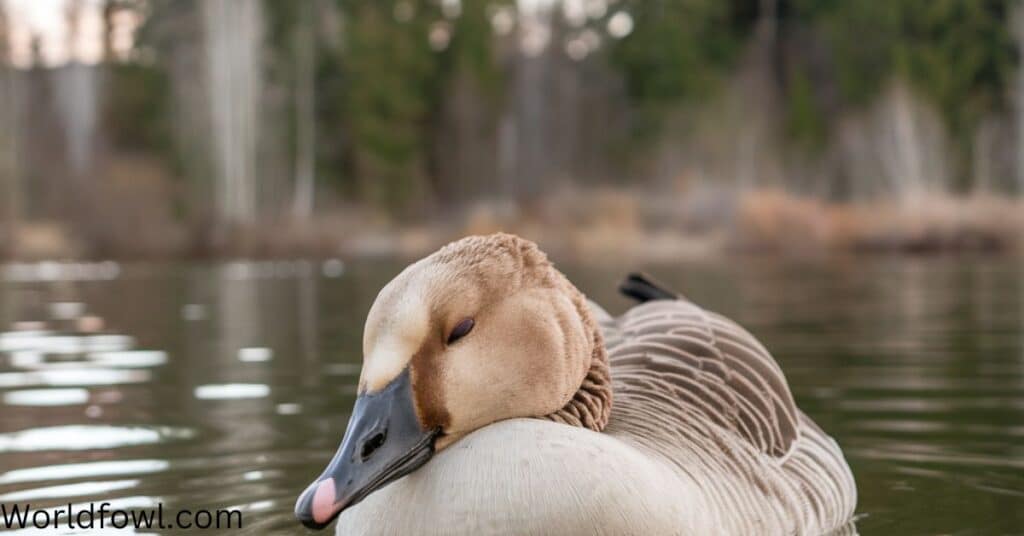Ever wondered where geese go when it’s time to hit the hay? You’re not alone! The sleep habits of these honking heroes have puzzled scientists and bird enthusiasts for years. From their choice of bedtime locations to their unusual sleeping positions, geese have some truly fascinating snoozing secrets. Let’s dive into the world of goose slumber and uncover the mysteries of Where Do Geese Sleep, how geese sleep, and why their rest routines are so darn interesting.
The Enigma of Goose Sleep
Geese, those majestic waterfowl that grace our parks, lakes, and skies, have long captured our imagination. But while we often see them waddling about during the day or flying in their iconic V-formations, their nighttime habits remain shrouded in mystery for many. Do geese sleep on the water? Do they find cozy spots on land? And what about those adorable goslings – where do baby geese sleep?
These questions aren’t just fodder for curious birdwatchers. Understanding geese sleep patterns can offer valuable insights into avian behavior, adaptation, and even evolution. So, let’s ruffle some feathers and get to the bottom of this feathery mystery!
The Goose’s Cozy Spots: Where Do These Birds Bed Down?
When it comes to where geese sleep, these clever birds have a variety of options at their disposal. Let’s explore the different sleep locations geese choose and why they might prefer one spot over another.
On Terra Firma: Grassy Havens and Shoreline Snooze Zones
Contrary to what you might think, geese don’t always sleep on water. In fact, many geese prefer to catch their Z’s on solid ground. Here’s where you might find geese sleeping on land:
- Grassy fields: Open areas provide good visibility, allowing geese to spot potential predators.
- Shorelines: The intersection of land and water offers quick escape routes if danger approaches.
- Islands: These isolated spots provide extra protection from land-based threats.
Geese often choose these terrestrial sleeping spots when they’re nesting or molting, as they offer more stability and protection for vulnerable birds.
Floating Fortresses: The Truth About Aquatic Napping
Now, let’s address the burning question: do geese sleep on the water? The answer is a resounding yes! Many geese, especially those in areas with limited land access, opt for aquatic snoozing. Here’s why water can be an ideal bedroom for geese:
- Safety: Sleeping on water keeps geese safe from land predators.
- Temperature regulation: Water helps geese maintain a comfortable body temperature.
- Easy escape: If danger threatens, geese can quickly take flight from the water’s surface.
However, sleeping on water isn’t without its challenges. Geese must contend with currents, waves, and the constant need to stay afloat. It’s a testament to their adaptability that they can get a good night’s rest while bobbing on the surface!
Urban Geese: Adapting Sleep Locations in Human Environments
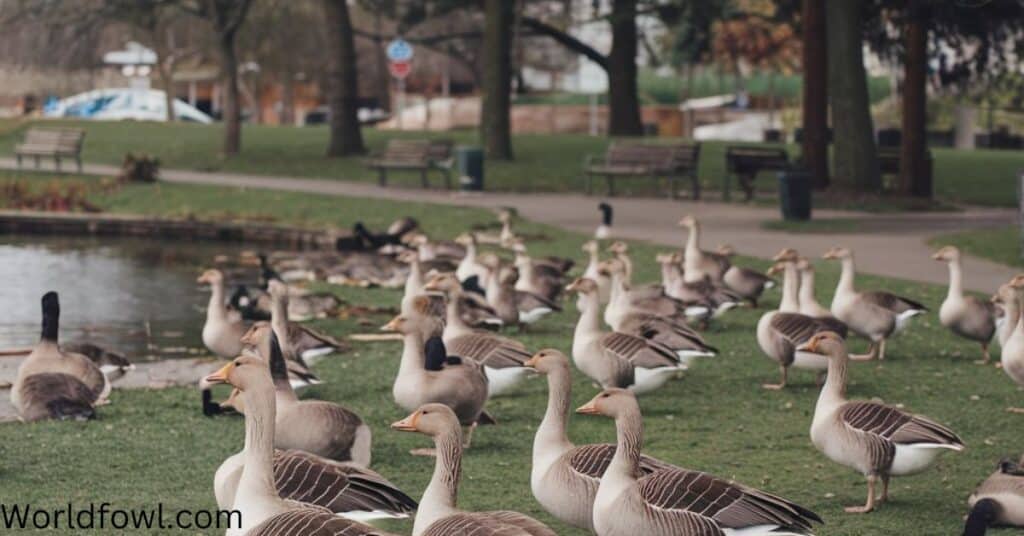
As human populations expand, geese have had to adapt their sleeping habits to urban and suburban environments. Where do geese go to sleep in these areas? You might be surprised:
- Park lawns: City parks often provide expansive grassy areas for geese to rest.
- Golf courses: The well-manicured greens of golf courses are attractive to sleepy geese.
- Rooftops: Some urban geese have been known to roost on flat rooftops, especially during nesting season.
These adaptations show just how resilient and flexible geese can be when it comes to finding a safe place to sleep.
Gosling Slumber Party: Where Baby Geese Catch Some Shut-eye
Now, let’s turn our attention to the adorable goslings. Where do baby geese sleep? Their sleep locations and patterns are crucial for their survival and development.
Nesting Nooks: The Early Days of Sleep
In their first few days of life, goslings sleep right where they hatched – in the nest. These nests are typically located in safe, secluded areas such as:
- Dense vegetation near water bodies
- Small islands in lakes or ponds
- Elevated areas with good visibility
The mother goose provides warmth and protection during this vulnerable period, often covering the goslings with her wings as they sleep.
Group Snoozing: Safety in Numbers for Young Geese
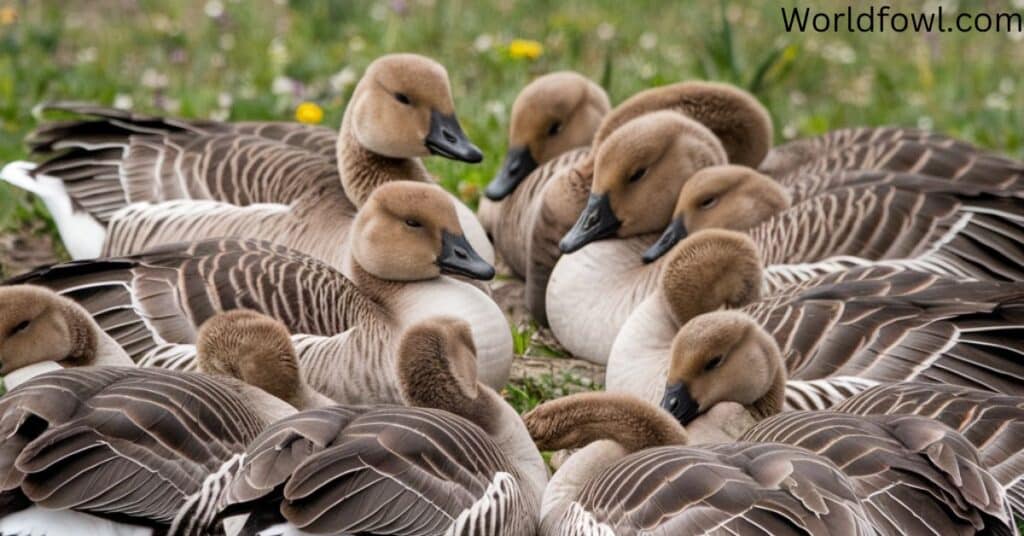
As goslings grow, they start to sleep in groups, often huddled together for warmth and safety. This behavior, known as “crèching,” offers several benefits:
- Increased vigilance: More eyes mean better chances of spotting danger.
- Shared warmth: Goslings can conserve energy by snuggling together.
- Predator confusion: A large group can make it harder for predators to single out individual goslings.
Transitioning to Adult Sleep Spots: A Gosling’s Journey
As goslings mature, they gradually adopt adult sleeping habits. This transition usually occurs over several weeks, with young geese:
- Spending more time sleeping on water
- Venturing further from the nest site
- Developing the ability to sleep with one eye open (more on this later!)
By understanding where baby geese sleep and how their sleep patterns evolve, we gain valuable insights into goose development and survival strategies.
Timing is Everything: When Do Geese Hit the Hay?
Geese sleep patterns are fascinating and complex. Let’s explore when these birds catch their shut-eye and how their sleep schedules adapt to various factors.
Diurnal vs. Nocturnal: Debunking Myths About Goose Sleep Schedules
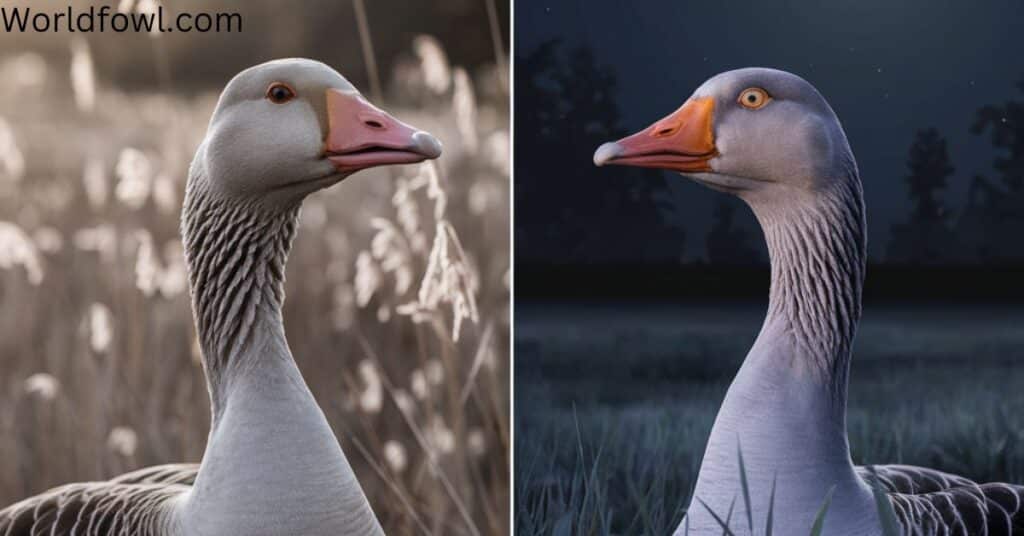
Contrary to popular belief, geese are neither strictly diurnal nor nocturnal. Instead, they exhibit a more flexible sleep pattern:
- Crepuscular tendencies: Geese are often most active during dawn and dusk.
- Adaptable sleep times: They can adjust their sleep schedule based on environmental factors and safety concerns.
- Short sleep periods: Geese typically sleep in short bursts rather than long, uninterrupted stretches.
This flexibility allows geese to maximize their foraging time while still getting the rest they need.
Seasonal Shifts: How Daylight and Migration Affect Sleep Patterns
Geese sleep patterns change dramatically with the seasons, particularly during migration periods. Here’s how seasonal factors impact goose sleep:
| Season | Sleep Pattern | Influencing Factors |
| Spring | Irregular | Nesting, longer days |
| Summer | More daytime rest | Abundant food, safety from predators |
| Fall | Reduced sleep | Preparation for migration |
| Winter | Longer sleep periods | Conservation of energy, shorter days |
During migration, geese may significantly alter their sleep routines, sometimes flying for extended periods with minimal rest.
Power Naps: The Secret to Goose Energy Management
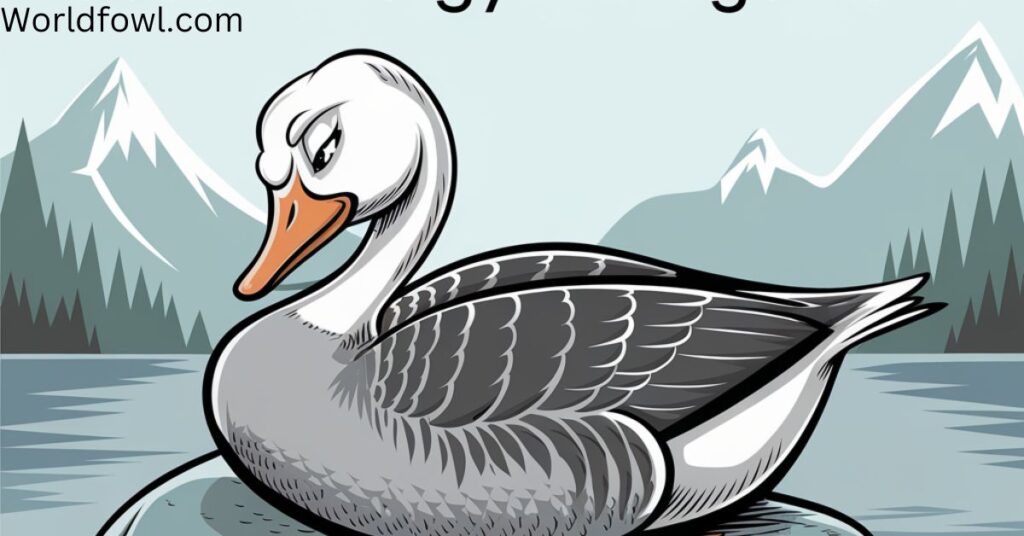
Geese have mastered the art of the power nap. These short sleep sessions allow them to rest while remaining vigilant. Key features of goose power naps include:
- Duration of 2-10 minutes
- Frequent occurrence throughout the day and night
- Ability to wake quickly if threats are detected
This napping strategy enables geese to balance their need for rest with the constant vigilance required for survival in the wild.
Goose Sleep 101: How These Birds Doze Off
Now that we know where geese sleep and when they do it, let’s explore the fascinating ways in which geese actually sleep. Their sleep mechanisms are truly remarkable adaptations that ensure both rest and safety.
The Art of Unihemispheric Slow-Wave Sleep
One of the most intriguing aspects of how geese sleep is their ability to engage in unihemispheric slow-wave sleep (USWS). This means:
- Only one half of their brain sleeps at a time
- The other half remains alert and vigilant
- They can switch which hemisphere is sleeping periodically
This adaptation allows geese to rest while still being aware of their surroundings, a crucial survival skill in the wild.
Vigilance While Snoozing: Keeping One Eye on the Prize
You’ve probably heard the phrase “sleep with one eye open.” Well, geese take this literally! Here’s how it works:
- The eye connected to the awake hemisphere stays open
- This eye scans for potential threats
- The other eye, connected to the sleeping hemisphere, remains closed
This remarkable ability allows geese to maintain a level of awareness even while resting, significantly enhancing their chances of survival.
The One-Legged Stance: Balancing Act or Sleep Strategy?
Have you ever wondered, “Do geese sleep on one leg?” The answer is yes, and there’s a good reason for it! This peculiar sleeping position serves several purposes:
- Heat conservation: Tucking one leg close to the body reduces heat loss
- Quick takeoff: Standing on one leg allows for faster flight response if threatened
- Muscle rest: Alternating legs gives each limb a chance to rest
While it might look uncomfortable to us, sleeping on one leg is a natural and beneficial posture for geese.
Waterbed Wonders: Do Geese Really Sleep on H2O?

We’ve touched on this earlier, but let’s dive deeper into the question: do geese sleep on water? The answer is a resounding yes, and it’s a fascinating aspect of their sleeping habits.
Buoyant Bedtime: Advantages of Aquatic Snoozing
Sleeping on water offers geese several benefits:
- Predator protection: Water creates a natural barrier against land-based threats
- Temperature regulation: Water helps geese maintain optimal body temperature
- Easy escape: Quick takeoff is possible directly from the water’s surface
- Rest during migration: Allows for rest stops during long flights over water bodies
Dangers and Adaptations for Water-Based Rest
While sleeping on water has its advantages, it’s not without risks. Geese have developed several adaptations to cope with these challenges:
- Waterproof feathers: Keep geese dry and insulated while sleeping on water
- Muscular legs: Allow geese to paddle occasionally to maintain position
- Heightened awareness: USWS helps geese stay alert to potential dangers
These adaptations enable geese to turn potentially dangerous water bodies into safe, comfortable sleeping spots.
Land vs. Water: How Geese Choose Their Sleep Environment
Geese don’t always opt for aquatic slumber. Their choice between land and water sleep locations depends on various factors:
- Weather conditions: Rough waters might drive geese to sleep on land
- Predator presence: Higher land predator activity might encourage water sleeping
- Nesting season: Geese with goslings often prefer land-based sleep spots
- Food availability: Proximity to feeding areas can influence sleep location choice
By weighing these factors, geese make informed decisions about the safest and most comfortable place to catch some Z’s.
Nature’s Night Watchmen: Geese and Their Remarkable Sleep Adaptations
Geese have developed some incredible adaptations that allow them to sleep safely in various environments. Let’s explore how these birds act as nature’s own night watchmen.
Group Dynamics: Taking Turns as Sentinels
Geese often sleep in groups, and they’ve developed a clever system to ensure the safety of the flock:
- Rotating sentinels: Some geese remain awake while others sleep
- Alarm calls: Sentinel geese will honk loudly if they detect danger
- Group positioning: Geese on the outskirts of the group tend to be more alert
This cooperative behavior significantly enhances the overall safety of the flock during rest periods.
Light Sleepers: How Geese Stay Alert to Danger
Geese are notoriously light sleepers, a trait that serves them well in the wild. Here’s how they maintain their vigilance:
- Sensitive hearing: Geese can detect subtle sounds even while sleeping
- Quick wake response: They can transition from sleep to full alertness almost instantly
- Environmental awareness: Geese remain cognizant of their surroundings even during rest
These traits ensure that geese can respond swiftly to potential threats, even during their deepest sleep phases.
The Role of Vocalization in Goose Sleep Patterns
Geese are known for their distinctive honks, but did you know these vocalizations play a crucial role in their sleep patterns? Here’s how:
- Sleep-talking: Geese may emit soft honks while sleeping, possibly as a way to maintain group cohesion
- Alarm calls: Loud honks serve to wake sleeping flock members if danger is detected
- Reassurance sounds: Quiet vocalizations between pair-bonded geese may occur during rest periods
These vocalizations contribute to the complex social dynamics of sleeping geese flocks, enhancing their overall safety and group cohesion.
Sleep on the Wing: Migrating Geese and Their Rest Routines
One of the most impressive feats in the animal kingdom is the long-distance migration of geese. But how do these birds manage their sleep during these epic journeys?
In-flight Napping: Myth or Marvel?
The idea of geese sleeping while flying might sound like science fiction, but there’s some truth to it! Here’s what we know:
- Micro-naps: Geese may take very short naps during flight, lasting only seconds
- Altitude assistance: Higher altitudes with smoother air may facilitate in-flight rest
- USWS in action: Unihemispheric sleep allows for rest while maintaining flight
While geese don’t enter deep sleep during flight, these adaptations allow them to rest without interrupting their journey.
Stopover Strategies: Recharging During Long Journeys
Despite their ability to nap on the wing, geese still need proper rest during migration. They employ several strategies at stopover sites:
- Group resting: Taking turns sleeping and keeping watch
- Safe locations: Choosing stopover sites with minimal predator activity
- Efficient foraging: Balancing rest time with the need to refuel for the next leg of the journey
These stopover periods are crucial for geese to maintain their energy levels during long migrations.
How Migration Affects Overall Sleep Patterns
Migration significantly impacts geese sleep patterns:
- Reduced total sleep time: Geese sleep less during migration periods
- Increased sleep intensity: When they do sleep, it tends to be deeper and more restorative
- Altered circadian rhythms: Migration can disrupt normal day-night sleep cycles
These changes highlight the remarkable adaptability of geese and their ability to modify their sleep patterns to meet the demands of their annual journeys.
The Science Behind Goose Sleep: What Researchers Have Discovered
Scientific studies have shed light on many aspects of goose sleep, revealing fascinating insights into these birds’ rest routines.
Recent Studies and Their Surprising Findings
Here are some key discoveries from recent research on geese sleep patterns:
- Brain wave patterns: EEG studies have confirmed the occurrence of USWS in geese
- Sleep duration: Wild geese average about 7 hours of sleep per day, but this can vary widely
- Environmental influences: Factors like noise pollution and artificial lighting can significantly impact goose sleep quality
These findings help us understand not only goose behavior but also the potential impacts of human activity on wildlife sleep patterns.
Comparing Goose Sleep to Other Avian Species
When we compare geese sleep to that of other birds, some interesting patterns emerge:
| Species | Sleep Duration | USWS Capability | Primary Sleep Location |
| Geese | 7-8 hours | Yes | Water or land |
| Ducks | 10-12 hours | Yes | Water or land |
| Eagles | 10-12 hours | No | Trees or cliffs |
| Penguins | 4-6 hours | Yes | Land or ice |
This comparison highlights the unique adaptations of geese and how they’ve evolved to suit their specific ecological niche.
What Goose Sleep Can Teach Us About Animal Adaptation
The study of geese sleep patterns offers valuable lessons about animal adaptation:
- Flexibility: Geese demonstrate how sleep patterns can adapt to environmental changes
- Efficiency: Their ability to rest while remaining vigilant showcases efficient use of limited resources
- Social behavior: Group sleeping strategies in geese highlight the importance of social structures in survival
These insights can inform our understanding of sleep across the animal kingdom and even provide inspiration for human sleep research.
Conclusion
As we’ve seen, the sleep habits of geese are far more complex and fascinating than one might initially think. From their ability to sleep with one eye open to their impressive in-flight napping skills, geese have developed a range of adaptations that allow them to rest effectively while staying safe in various environments.
Understanding where geese sleep, how geese sleep, and the intricacies of their sleep patterns does more than satisfy our curiosity. It provides valuable insights into:
- Ecological adaptations: How animals evolve to meet environmental challenges
- Wildlife conservation: The importance of protecting both daytime and nighttime habitats
- Sleep science: New perspectives on the function and flexibility of sleep across species
As we continue to study these remarkable birds, we’re likely to uncover even more secrets about their slumber. Who knows? The next breakthrough in sleep science might just come from observing a flock of

Henry James is a seasoned blogger and a passionate storyteller on “World Fowl.” With years of experience crafting engaging content, he brings a unique blend of expertise and creativity to his writing. Henry specializes in exploring diverse topics with depth and clarity, captivating readers worldwide.

